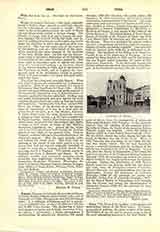

Csanad, Diocese of, includes the counties of Temes, Torontal, Krassb-Szoreny, Arad, Csanad, and a part of Csongrad and Bekes, Hungary, an area of 13,713 square miles. It is suffragan of Kaloesa, and has a population of 2,060,000 souls, of whom 824,000 are Catholics and 56,000 Uniat Greeks. The diocese has a cathedral chapter, 8 regular and 6 titular canonries, 8 titular abbeys, 1 provostship, 3 titular provostships, 6 archdeaneries, 24 subordinate deaneries, 236 parish churches, 1099 filial churches, 231 parish priests, 122 chaplains, 28 other ecclesiastics, 54 clerics, 8 retired ecclesiastics, 8 priests outside of the diocese. The male orders and congregations have 11 houses and 91 members, divided as follows: Piarists (who also conduct 3 gymnasia), 3 houses; Franciscans, 2; Minorites, 4; Brothers of Charity, 1, and priests of the Order of the Divine Savior, 1. The School Sisters of Notre-Dame, Sisters of Charity of St. Vincent de Paul, and Holy Cross Sisters have 28 convents and 484 members in the diocese. There is a seminary for priests (with a lyceum), a preparatory one for boys, and two training-schools, for male and female teachers. The cathedral built in barocco style, 1736-54, is dedicated to St. George. The residence of the bishop is at Temesvar. Csanad is one of the oldest sees of Hungary. It was created by King Stephen in 1035 and its first bishop was the Italian Abbot Gerardus, the tutor of Stephen’s son, Emmerich. In the thirteenth century the diocese suffered greatly from the invasion of the Mongols; in the fourteenth century, after the Turkish conquest of Servia, from the immigration of schismatic Serbs called Rascians into Hungary; in the sixteenth century from the rebellion of the peasants (1514). By order of Dbzsa, the leader of the peasants, Bishop Nicholas Csaky was impaled. After the battle of Mohacs (1526) in which Bishop Franz Csaholy (1514-26) was killed, almost the entire diocese fell into the hands of Zapolya, the ally of the Turks. When in 1552 Temesvar also was taken by the Turks the diocese was nearly ruined. The see had henceforth merely a nominal existence and the residence of the bishop was transferred in 1574 to Szegedin. It was only after the Treaty of Passarowitz (1718) freed the land from the yoke of the Turks that Bishop Ladislaus Nadasdy (1710-30) reentered the diocese; the depopulated territory was largely settled anew by German colonists. During the Revolution of 1848 Bishop Joseph Lonovics von Krivina (1834-48) was driven into exile; later the Hungarian minister of worship, Michael Horvath, was appointed bishop but was not consecrated. During the episcopate of Ladislaus Koszeghy (1800-28) the seminary for priests was founded; during that of Alexander Csajaghy (1851-60) the School Sisters of Notre-Dame were brought into the diocese, and during the administration of Alexander Bonnaz (1860-89) the seminary for boys was erected.
JOSEPH LINS

